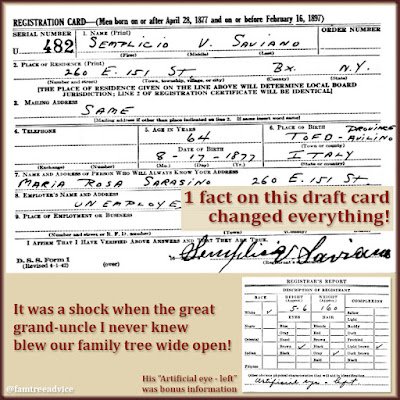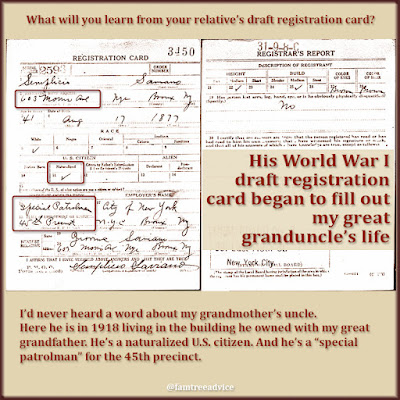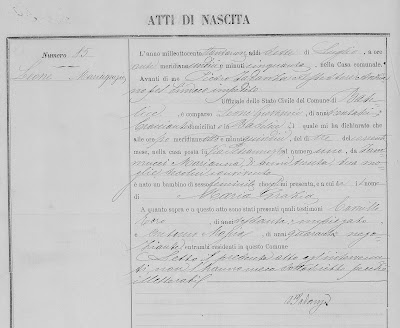I spent last Sunday jumping from one genealogy document to another. I had no research plan in mind. Instead, I let the documents lead the way.
In the 1933 death records of Colle Sannita, Italy, I found several pages of text about one man. Antonio Paolucci was my 4th cousin 3 times removed, born in 1887. As I studied the pages, looking for familiar Italian words, I struggled to find a date of death.
A few phrases started to come together. In World War I, Antonio served in the 1st "bersaglieri" regiment—an infantry corps of sharpshooters. The documents say Antonio's mother Carmela is his beneficiary; his father Nicola is already dead.
One date and place kept repeating: 28 October 1915, Castelnuovo Carsico. Antonio fought in a battle on that date and was never seen again. This document says Antonio is presumed to have died in that battle. It took 18 years for the army to make this declaration and give Antonio's mother her compensation.
I noticed the title on one page: "Sentenza di presunta morte di Paolucci Antonio." That's a declaration of the presumed death of my distant cousin Antonio.
 |
| It took all these pages to explain what happened to Antonio. And I still had to do a ton of research. |
Search Engines, Maps, and Translators
At this point I knew that cousin Antonio was an elite soldier lost in battle. But where is the place they called Castelnuovo Carsico? There are a few towns in Italy with Castelnuovo in their name, but I couldn't make anything of Carsico. I wondered if this was what they were calling a town in another country. Castelnuovo means new castle. Were they fighting in a town with a name that also translates to new castle?
When I typed "Carsico" into Google Translate, it translated to Karst. Aha! I remember Karst from my earlier World War I research. The Italian Army fought battles on the Karst Plateau in today's Slovenia, on the Italian border. Someone else in my family tree died in battle there. He was my 2nd cousin 3 times removed.
To try to locate the October 1915 battle, I used Wikipedia to learn about the Third Battle of the Isonzo. This battle happened at the right time, in October and November 1915. And it happened near the Italian town of Gorizia. Is there a town near Gorizia and the Karst Plateau with a name that translates to new castle?
Using Google Translate again, I found that Novi Grad is Slovenian for new castle. But the town of Novi Grad is much too far east of the Karst Plateau. We know that country borders were very fluid, and Slovenia may not have been Slovenia then. So I tried other languages. In German, the translation is Neues Schloss, but again, that town is much too far away. There's a Slovakian translation of Nový Zámok and a Czech translation of Nový Zámek; both are too far away.
I wish we could all use the in-country place names instead of translations!
 |
| My past research helped me find the place where my cousin must have died in battle. |
Stitching the Facts Together
Another website about the 1st Bersaglieri Regiment mentions Gorizia, Italy. I took a closer look at it on the map and found both a castle and a World War I museum. Each one is a short walk away from the Slovenian border.
The Gorizia Castle is on high ground overlooking Slovenia. What a perfect place to position your battalion of sharpshooters. But this medieval castle is not new.
At the northern edge of the castle, the map shows a "road" called Galleria Bombi. But it isn't a road. It's a tunnel that stretches from the main piazza of Gorizia to the border of Slovenia. I thought it meant "bomb tunnel," but it's named after Giorgio Bombi, an Italian politician and mayor of Gorizia. During the war, they may have used the tunnel strategically.
Gorizia Castle's website says it was reduced to a pile of rubble during the war. Italy didn't rebuild it until the 1930s. Antonio Paolucci's declaration of presumed death is from 1933. Could they have called the newly rebuilt Gorizia Castle the Castelnuovo?
I did find one website that places the 1st Bersaglieri Regiment at Castelnuovo in "Gorizzo." The timeline matches up. All the evidence I've found, when taken together, tells me that my cousin died in battle at Gorizia, Italy.
I've made this journey a few times now, learning about battles that claimed my relatives. I also learned about one battle that made my grandfather a POW for a solid year. My 28-year-old cousin Antonio was at least 12 hours away from home, sent into battle because of his shooting skills. I'm glad I can symbolically lay him to rest, pushing in that map pin at the place where he fought for his country.
I started the day with some aimless genealogy research. I ended it with a full-blown story about my cousin Antonio.




















